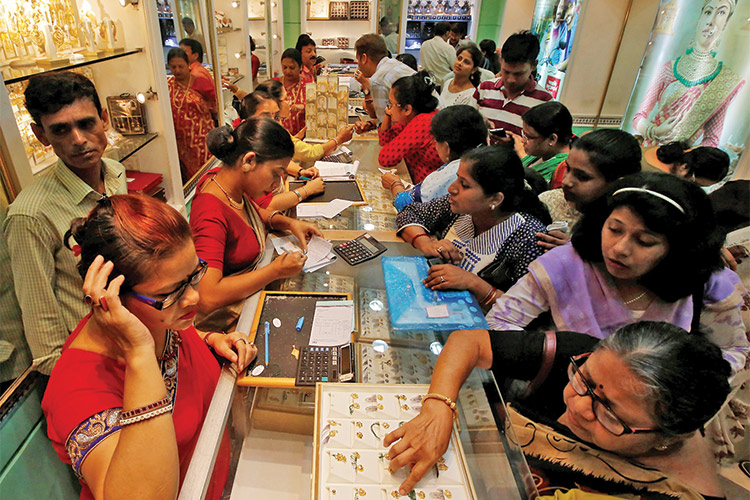Gold flips to premium as sales improve in most Indian hubs

People buy gold ornaments at a jewellery shop in Kolkata. Reuters
In India, the world’s second biggest consumer of the metal after China, dealers were charging a premium of up to $1 an ounce over official domestic prices this week, up from last week’s discount of up to $2. The domestic price includes a 10 per cent import tax.
“Right now, demand is good. The price correction is giving jewellers an opportunity to replenish inventory at lower levels,” said Mukesh Kothari, director at Mumbai bullion dealer RiddiSiddhi Bullions.
Gold futures in India fell to Rs31,777 per 10 grammes, the lowest level since Jan.9.
Jewellers have been making healthy purchases as retail demand for weddings is expected to improve if prices remain at the current level, said a Mumbai-based dealer with a bullion importing bank.
The yellow metal is considered an essential part of weddings in India.
The Gold market in China also saw increased demand, pushing premiums higher to $9-$13 over the global benchmark from the previous week’s $8-$11.
“Since March 8 is also a festival in China, this week’s jewellery demand has also been slightly better compared to normal days,” said Samson Li, a Hong Kong-based precious metals analyst at Refinitiv GFMS.
However, consumption had dried up a bit with consumers having already exhausted their spending during the Lunar New Year holiday, Li added.
Singapore witnessed slight demand as well, mostly due to a dip in global prices earlier this week, said Brian Lan, managing director at dealer GoldSilver Central in Singapore.
Benchmark spot gold prices touched an over five-week low of $1,280.70 this week.
Premiums of around 60-80 cents were being charged over the benchmark in Singapore, traders said, little changed from 50-80 cents previously.
“Gold prices in the local currency are also stagnant, which has not excited investors much,” said a Singapore-based trader.
Hong Kong markets were, however, relatively quiet, with premiums unchanged at 50 cents to $1.30 an ounce. In Japan, the metal was sold at par with the global benchmark, compared with a discount of about 50 cents last week, a Tokyo-based trader said. The fallout from the US-China trade war has led to slower industrial demand for the metal, he added.
Meanwhile, gold rose a per cent to a one-week high on Friday in global markets, briefly breaching the pivotal $1,300-per-ounce ceiling, as weak US payroll data dented the dollar and risk sentiment, while also exacerbating a gloomy global economic picture.
US job growth almost stalled in February with the economy creating only 20,000 jobs amid a contraction in payrolls in construction and several other sectors.
Spot Gold was up 1 per cent at $1,298.66 per ounce, en route to a weekly gain of 0.4 per cent. Prices on Thursday fell to $1,280.91, within striking distance of a more than five-week low touched earlier this week. US Gold futures settled up 1 per cent at $1,299.30.
“We saw a surprisingly weak non-farm jobs number that pressured the dollar and the US stock markets, which in turn supported the rally in gold,” said Jim Wyckoff, senior analyst at Kitco Metals. “Gold is going to be influenced by the dollar index.”
The dollar held its earlier losses versus a basket of currencies, making bullion cheaper for holders of other currencies, while Wall Street was set to fall after the jobs data.
“Growth in the US is going to slow as the country has reached full employment and productivity is very high so there isn’t much space for growth. And we’re coming to an end of the Federal Reserve’s rate cycle, which should weaken the dollar further,” said Natixis analyst Bernard Dahdah.
While Friday’s report from the Labour Department did have a few bright spots, such as dip in the unemployment rate and an upward revision to December and January data, it did indicate the US economy is slowing, supporting the Fed’s “patient” approach toward interest rate hikes this year.
The jobs number could be revised up and the “internals” were not so bad, Kitco’s Wyckoff said.
“I don’t think this particular report alone will alter the Fed’s monetary policy,” he said. “If we get a string of weak numbers next couple of months, then that’s a different story, but right now that 20,000 rise in non-farm is an anomaly.”
Investors also kept a close eye on trade talks between the United States and China, with mixed signals from Washington on the likelihood of a breakthrough.
Reuters



